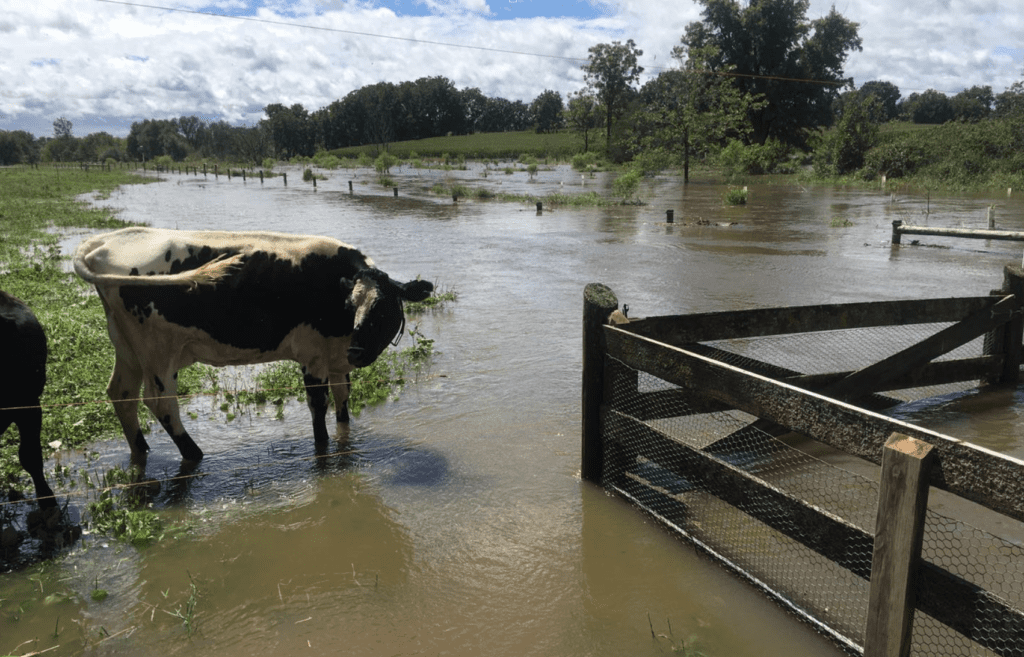
In the summer of 2023, a massive rain event inundated Willow Run Farmstead in Berks County, Pennsylvania.
Deanne Boyer raises grass-fed beef and pasture pork on Willow Run Farmstead in Reading, Pennsylvania, at the seat of Berks County. The farm has been in her family for at least three generations and has pastures that run alongside two different creeks on the property, much of which is in the 100-year floodplain.
While the farm is no stranger to flooding, on July 9, 2023, they were inundated with 10 inches of rain in a 24-hour period—the most Deanne had ever seen. When she checked with older family members who still remember Hurricane Agnes coming through the region, they confirmed that this storm was more intense, with water levels tipping the five-foot mark on their fences.
The storm, part of the same weather event that caused historic flooding in Vermont and across the Northeast, hit Reading first and caused record damages, resident evacuations, and infrastructure and property losses.
A rain event like this is called a 100-year storm, meaning it has a 1% chance of occurring each year, based on historical data. As climate change shifts from a looming threat to being part of our daily reality, the frequency of extreme weather events is on the rise. We’ve already seen this particular history repeat itself, with catastrophic floods striking Vermont again this summer.
“We don’t get casual rains anymore,” Deanne says. “We just get downpours or nothing.”
In 2017, Willow Run installed riparian buffers along the creeks to help soak up and slow flood waters. They put the lowest-lying pasture along the creeks in the USDA Conservation Reserve Enhancement Program. They also built berms along their driveway—where floodwater tends to flow from a neighbor’s property—to divert the water into their pasture.
According to Deanne though, the biggest protection is in the pasture itself, which has been in Pasa’s Soil Health Benchmark Study for five years. Willow Run’s water infiltration has been measured at five inches per hour—an impressive rate of absorption—so the pastures acted as a temporary holding tank for the rainwater.
Perennial pasture-based systems like Willow Run consistently score top marks on key soil health indicators.
But 10 inches of rainfall in 24 hours is too much for even the healthiest soils to absorb, and the storm created serious challenges that required dramatic action.
The Boyers had to move their livestock to the highest ground during the downpour, but thankfully didn’t lose a single animal. They also spent hours out in the rain digging deeper ditches to divert more water into their pastures.
While the impact on the Reading area and the broader Northeast was devastating, Willow Run ultimately escaped with minimal damage. Double sump pumps protected the Boyers’ basement from flooding. They mainly had a lot of clean-up to do—clearing mud and debris from the barnyard and untangling branches that got stuck in their high-tensile fencing.
“When the National Weather Service says we’re getting lots of rain, I take it very seriously,” said Deanne.
Deanne credits good planning and healthy soils for Willow Run’s ability to weather that storm, but she knows they haven’t seen the worst yet.
She reports, “I am now planning for the 12-inch rain event in a 24-hour period.”
Watch a recording of our recent Flood Mitigation webinar, where Deanne and another Pennsylvania farmer discuss how they’ve navigated increased flooding (and drought).
Read our 2024 Report: Flood Mitigation Practices and Policies with recommendations for both farmers and legislators.
Were you impacted by the recent floods in Vermont? Connect with NOFA-VT for local resources.
Learn about our Climate-Smart Farming and Marketing Program, supporting farmers across the Northeast and Eastern Seaboard in implementing practices to help them adapt and be part of the solution.